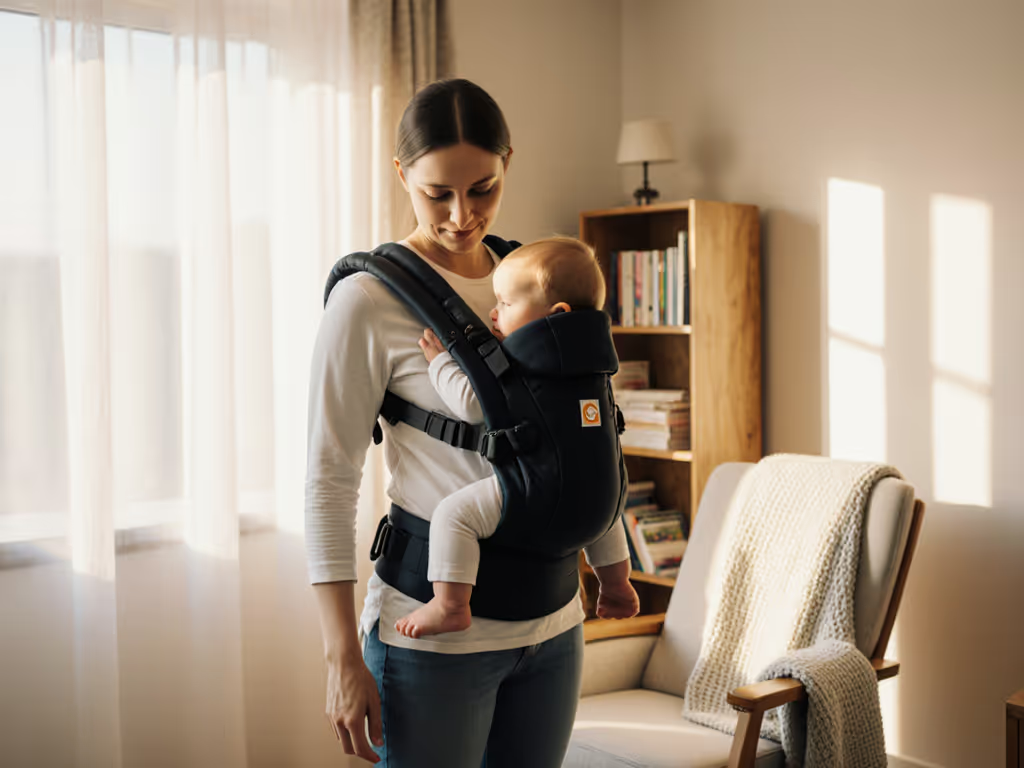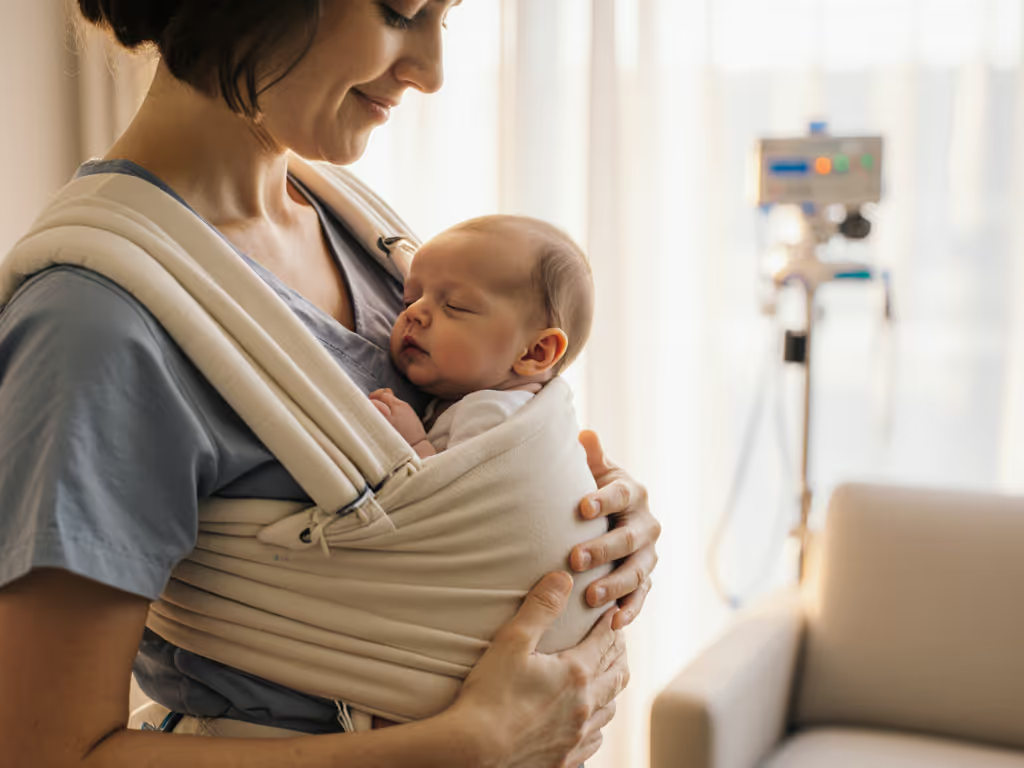
7 Babywearing Comfort Tips Every Caregiver Should Know

Did you know that babywearing can reduce infant crying by up to 43 percent? Choosing how to carry your baby affects everything from your comfort to your child’s safety and happiness. With options ranging from wraps to sturdy carriers, finding the right fit is no small task. By understanding what to look for, you set the stage for a more enjoyable and secure bonding experience every time you wear your baby.
Quick Summary
| Takeaway | Explanation |
|---|---|
| 1. Choose a carrier that fits well | Comfort and fit are essential for both you and your baby; different styles may suit different caregivers. |
| 2. Adjust straps for weight distribution | Proper strap adjustments prevent discomfort and strain, ensuring both you and your baby are well-supported. |
| 3. Ensure proper baby positioning | Follow the T.I.C.K.S. guideline to maintain your baby's safety and comfort during carrying. |
| 4. Regularly inspect your carrier | Frequent checks for wear and tear are vital, as damaged carriers can jeopardize your baby's safety. |
| 5. Take breaks and listen to your body | Frequent breaks help prevent physical strain; respect your body's signals to ensure a comfortable experience. |
1. Choose the Right Carrier for Your Body and Baby
Picking the perfect baby carrier is like finding your ideal pair of shoes - it needs to fit you and your little one just right. Not all carriers work the same for every caregiver or infant, which means you might need to experiment to find your perfect match.
Your carrier should feel comfortable and secure for both you and your baby. Body type compatibility matters significantly. Some parents discover that what works beautifully for one person might feel awkward or uncomfortable for another. According to parenting experts, it is totally normal for different family members to prefer different carrier styles.
Fit and adjustment are key considerations. The National Childbirth Trust suggests that carriers might require individual strap modifications to suit each wearer. Think of it like adjusting a car seat or bicycle - personal comfort ensures better long term use.
Types of Carriers to Consider
Some carrier styles offer more versatility than others:
- Wraps: Flexible and often one size fits all
- Structured carriers: More rigid with specific adjustments
- Slings: Quick to put on but require practice
When selecting a carrier, test it out beforehand if possible. Move around. Simulate walking. Bounce slightly. Your carrier should feel like a natural extension of your body.
Remember that learning to use a new carrier takes practice. Give yourself grace during the initial adjustment period. Your comfort and your baby's safety are the top priorities.
2. Adjust Straps for Even Weight Distribution
When you wear your baby, how you distribute weight can make the difference between a comfortable experience and an agonizing one. Proper strap adjustment is not just about comfort its about preventing potential strain and ensuring both you and your baby feel supported.
Weight distribution is critical for preventing back and shoulder fatigue. Pediatric experts emphasize that an ergonomically adjusted carrier can help you maintain good posture while keeping your baby close. Think of it like wearing a well fitted backpack the right adjustment means you barely notice the weight.
Practical Strap Adjustment Tips
To achieve optimal weight distribution, focus on these key areas:
- Adjust shoulder straps so they sit flat against your shoulders
- Ensure the waistband sits at your natural waist
Pay close attention to padding and support. The carrier should have sufficient cushioning in the shoulder straps and waistband to prevent pressure points. Breathable fabric matters too. You want material that wicks moisture and allows air circulation.
A well adjusted carrier provides multiple benefits. It reduces physical strain on your body. It keeps your baby positioned safely. And it allows you to move naturally without constantly readjusting.
Pro Tip: When first putting on your carrier, do a quick bounce test. If you feel any sharp pain or uneven pressure its time to readjust.
Remember that finding the perfect fit might take some practice. Be patient with yourself and make small adjustments until everything feels just right.
3. Check Baby's Position for Proper Support
Every baby carrier comes with an invisible instruction manual written in the language of safety and comfort. Getting your baby's position right is not just about looking adorable its about protecting their developing body and ensuring their wellbeing.
Proper positioning is crucial for your infant's physical development. The baby wearing community has developed a simple yet powerful guideline known as T.I.C.K.S.:
- Tight: Carrier should be snug against your body
- In view: Always be able to see your baby's face
- Close enough to kiss: Baby should be high enough to easily kiss their head
- Keep chin off chest: Ensure clear airway and breathing space
- Supported back: Maintain natural spine curvature
Manufacturers provide specific guidelines about carrier use based on your baby's age, weight, and developmental stage. Some carriers are designed for newborns while others work best for older infants. Always check the specific recommendations for your particular carrier.
A well positioned baby can breathe easily and feels secure. Their spine should maintain a natural curved position. Think of it like creating a second womb environment where they feel protected and comfortable.
Warning: Never compromise on your baby's positioning. When in doubt, consult a baby wearing expert or your pediatrician.
Practice makes perfect. Take time to learn how to position your baby correctly. Watch tutorial videos. Ask experienced parents. Your careful attention ensures your baby's safety and comfort.
4. Use Breathable Fabrics for All Climates
Choosing the right fabric for your baby carrier is like selecting the perfect outfit for a day that could swing from chilly morning to sunny afternoon. Breathability matters more than you might think.
Temperature regulation is crucial when baby wearing. Some carriers trap heat and moisture creating an uncomfortable environment for both you and your little one. Mesh panels and lightweight materials can be game changers in managing body temperature.
Fabric Considerations
When selecting a carrier fabric consider these key factors:
- Natural fibers like cotton offer good breathability
- Synthetic mesh panels provide excellent air circulation
- Lightweight materials prevent overheating
Summer carries require special attention. That extra layer of fabric pressed against your body can quickly become uncomfortably warm. Look for carriers with strategic ventilation zones that allow air movement while maintaining the necessary support and closeness.
Pro Tip: In warmer weather opt for lighter colored carriers that absorb less heat and choose carriers with open weave or mesh sections.
Beyond temperature comfort breathable fabrics also help prevent skin irritation and reduce the chance of excessive sweating. Your baby will appreciate a carrier that keeps them cool and comfortable no matter the weather.
Remember that every climate and body type is different. What works perfectly in a dry desert might feel different in a humid environment. Be prepared to experiment and find the right fabric combination for you and your baby.
5. Prioritize Hip and Neck Support for Infants
Your infant's delicate body requires strategic support during babywearing that goes far beyond simple comfort. Proper positioning protects their developing musculoskeletal system and ensures safe transportation.
Neck and hip alignment are critical developmental considerations. Infants cannot support their own head and spine independently. This means every carrier interaction must prioritize gentle structural support that mimics their natural resting position.
Critical Support Zones
When assessing carrier support look for these key elements:
- Neck support: Prevents head from flopping
- Hip positioning: Allows natural leg spread
- Spine alignment: Maintains gentle curved posture
Healthcare professionals emphasize that an infant's spine is incredibly flexible. A well designed carrier should create a natural M shaped position where the baby's knees are higher than their bottom. This positioning supports healthy hip development and reduces strain.
Warning: Avoid carriers that force your baby into a straightened leg position. This can potentially impact hip joint development.
Different age groups require different support strategies. Newborns need more head and neck assistance. Older infants can handle more movement. Always match your carrier style to your baby's current developmental stage.
Careful attention to these details transforms babywearing from a simple transportation method into a nurturing developmental experience. Your mindful approach protects your infant while keeping them close and secure.
6. Regularly Inspect Carrier Fit and Condition
Your baby carrier is more than just a piece of fabric its a safety system that requires consistent attention and care. Regular inspections are not optional they are essential for protecting your most precious cargo.
Wear and tear happens quickly with frequent use. Fabric stress from repeated stretching body weight and constant movement can compromise your carrier's structural integrity before you even realize it.
Critical Inspection Checkpoints
Before each use examine these key areas:
- Fabric integrity: Look for thin spots or emerging holes
- Strap strength: Check for fraying or stretched elastic
- Fastener security: Ensure buckles and clips work smoothly
- Seam conditions: Verify no loose threads or separating stitches
Second hand carriers require extra scrutiny. Just because a carrier looks fine does not mean it is safe. Invisible damage can lurk beneath seemingly perfect surfaces.
Warning: Never use a carrier with any signs of structural compromise. Your baby's safety is worth a replacement.
Make carrier inspection a routine. Do a quick check every time before putting your baby in. Think of it like buckling a car seat or checking a bike helmet. A 60 second inspection could prevent a potential accident.
Consider keeping a small repair kit for minor fixes. But remember that significant damage means its time to retire the carrier. Your baby's safety is worth far more than trying to extend the life of worn equipment.
7. Take Breaks and Listen to Your Body's Signals
Babywearing is an incredible bonding experience but it is not an endurance marathon. Your body communicates important messages about comfort and limits that you need to hear and respect.
Physical signals are your body's way of preventing potential injury and burnout. Carrying a baby requires significant muscular engagement. Pushing beyond your natural comfort zone can lead to unnecessary strain and potential long term physical issues.
Practical Break Strategies
Consider implementing these mindful break techniques:
- Time limits: Short supervised carries of 1 to 2 hours maximum
- Frequency: Check baby positioning every 30 minutes
- Stretch breaks: Pause and reset your body position
- Hydration: Drink water during breaks
Weight distribution matters. Even the most ergonomic carrier cannot eliminate all physical stress. Your muscles will fatigue. Your joints will request rest. Listening and responding is crucial.
Warning: Sharp or persistent pain is not normal. Stop and reassess your carrying technique.
Breaks are not a sign of weakness. They are a sign of intelligent self care. Every pause allows you to reset your posture adjust your carrier and ensure both you and your baby remain comfortable.
Remember that babywearing should feel natural. If it consistently feels like a struggle something needs adjustment. Your comfort directly impacts your baby's experience.
Below is a comprehensive table summarizing key considerations and strategies for selecting and using a baby carrier as discussed in the article.
| Aspect | Key Considerations | Benefits/Importance |
|---|---|---|
| Carrier Selection | Choose based on body type compatibility; Try different styles like wraps, structured carriers, and slings. | Ensures comfort and security for both parent and baby. |
| Strap Adjustment | Adjust shoulder straps and waistband for even weight distribution. | Prevents strain and ensures ergonomic posture. |
| Baby Positioning | Follow T.I.C.K.S.: Tight, In View, Close Enough to Kiss, Keep Chin Off Chest, Supported Back. | Protects baby's physical development and ensures safety. |
| Fabric Choice | Use breathable, lightweight materials like cotton and mesh. | Manages body temperature and prevents overheating. |
| Support Needs | Check for proper neck and hip support, especially for infants. | Protects developing musculoskeletal system. |
| Carrier Inspection | Regularly check fabric integrity, strap strength, and fastener security. | Ensures safety through the carrier's reliable condition. |
| Break Strategies | Implement time limits, frequent positioning checks, and stretch breaks. | Prevents physical strain and promotes self-care. |
Enhance Your Babywearing Comfort and Safety Today
Finding the right baby carrier and mastering its use can be challenging. You want a solution that fits your body, supports your infant's delicate neck and hips, and keeps you both comfortable in any climate. The article highlighted common struggles like adjusting straps for even weight distribution and ensuring proper positioning to protect your baby’s development. These concerns show why every caregiver deserves access to clear, trustworthy guidance.
At Caregiver Carry, we understand how important your babywearing experience is for bonding and safety. Our comprehensive resources offer detailed guides and expert-backed reviews to help you select the best carrier tailored to your needs. Whether you are choosing between wraps, slings, or structured carriers or need step-by-step tips on proper ergonomic positioning, our site offers practical support. Prioritize your comfort and your baby’s wellbeing by visiting Caregiver Carry now and discover how to make babywearing a joyful, safe journey for you both.
Frequently Asked Questions
How do I choose the right baby carrier for comfort?
To choose a comfortable baby carrier, prioritize body type compatibility and fit adjustments. Experiment with different styles, such as wraps or slings, to find what feels best for you and your baby. Test each carrier by moving around and simulating activities to ensure it feels natural.
What are the best practices for adjusting straps on a baby carrier?
Adjusting straps for even weight distribution is crucial for comfort and posture. Make sure shoulder straps sit flat against your shoulders and the waistband rests at your natural waist. Regularly check the padding and support to prevent pressure points while carrying your baby.
How can I properly position my baby in the carrier?
Use the T.I.C.K.S. guideline to ensure your baby is well-positioned: Tight, In view, Close enough to kiss, Keep chin off chest, and Supported back. Check that your baby's knees are elevated, forming an M shape to support healthy hip development. Always verify their head and neck are secure and properly aligned.
What kind of fabric should I look for in a baby carrier?
Select breathable fabrics to maintain comfortable temperature regulation while babywearing. Look for natural fibers like cotton or carriers with mesh panels for optimal air circulation. Ensure the material is lightweight to prevent overheating in warmer weather, enhancing both your and your baby's comfort.
How often should I check my carrier for wear and tear?
Inspect your baby carrier regularly, ideally before each use, to ensure it's in safe condition. Check for fabric integrity, strap strength, and fastener security, watching for any signs of wear like fraying or weak points. This quick 60-second check can prevent safety issues and ensure a secure carrying experience.
How can I listen to my body while babywearing?
Pay attention to physical signals like discomfort or fatigue during babywearing sessions. Implement short carrying periods of 1 to 2 hours maximum, take breaks every 30 minutes to reassess, and ensure you stay hydrated. Regular self-checks will help you maintain comfort and avoid strain.



